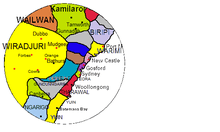Darkinjung language
Darkinjung (Darrkinyung; many other spellings; see below) is an Australian Aboriginal language, the traditional language of the Darkinjung people. While no audio recordings of the language survive, several researchers have compiled wordlists and grammatical descriptions. It has been classified as a language no longer fully spoken[3] and it can be classified as needing a language renewal[4] program. It was spoken adjacent to Dharuk, Wiradhuri, Guringai, Gamilaraay, and Awabakal. The Darkinjung tribe occupied a small part of southeastern Australia inside what is now the New South Wales area. They likely inhabited a considerable tract of land within Hunter, Northumberland, and Cook counties.[5]
| Darkinjung | |
|---|---|
| Hawkesbury–MacDonald River | |
| Region | New South Wales, Australia |
| Ethnicity | Darkinjung, Darkinung |
| Extinct | before sound recordings |
| Revival | A small number of second-language users in revival program |
Pama–Nyungan
| |
| Dialects |
|
| Language codes | |
| ISO 639-3 | xda |
| Glottolog | hawk1239[1] |
| AIATSIS[2] | S65 |
Alternate Names
The name of the language has various spellings as recorded by both Mathews and W.J. Enright, among others, whom worked off of documentation from the 19th century:[6]

- Darkinjang (Tindale 1974)
- Darkinjung
- Darkiñung (Mathews 1903)
- Darrkinyung
- Darginjang
- Darginyung
- Darkinung
- Darkinoong
- Darknüng
- Darkinyung
Revitalisation effort
Since 2003 there has been a movement from the Darkinyung language group to revitalise the language. They started working with the original field reports of Robert H. Mathews and W. J. Enright. Where there were gaps in the sparsely populated wordlists, words were taken from lexically similar nearby languages. This led to the publication of the work Darkinyung grammar and dictionary: revitalising a language from historical sources.[6] This may be ordered from the publisher, Muurrbay Language Centre at http://www.muurrbay.org.au/muurrbay-resources/.
Phonology
Much of our understanding of Darkinjung comes from papers published by R.H. Mathews in 1903. When analyzing these sources, we may generalize that there were around 15 consonants phonemes, and approximately 3 vowels.[6]
Consonants
| Bilabial | Dental | Alveolar | Palatal | Velar | |
|---|---|---|---|---|---|
| Oral Stop | b | d̪ | d | ɟ | g |
| Nasal | m | n̪ | n | ɲ | ŋ |
| Trill | r | ||||
| Approximant | w | ɹ | j | ||
| Lateral Approximant | l |
In Darkinjung, like many Australian languages, b, d, and g are interchangeable with p, t, and k and will not change the meaning of the word. The fact that this table shows b, d, and g is arbitrary.
Vowels
| Front Unrounded | Central Unrounded | Back Rounded | |
| High | ɪ | ʊ | |
| Low | ɐ |
Morphology
"Tags"[6]
Darkinjung makes use of what Mathews refers to as "tags," or suffixes to denote relationships between objects in sentences.[6]
Number tags -bula "two" and -biyn "several"
miri-bula a couple of dogs
Possessor Tag: -gayi
'a man's boomerang'guri- gayi bargan man POSS boomerang
Locative "at, on, in" tags: -a/ -da/ -dja/ -ga/ -wa
- The locative tags -ga and -wa appear to be found after stems ending in vowels.[6]
gawin-da nhayi bank-Loc that.over.there - 'on the other side'
Words with locational information seem to coincide with nouns that also carry a locative tag:
wallang-gayn-dja gundji-ga gara-dhi behind-?-Loc hut-Loc hide-Pres - 'around the house, hidden'
Ergative case tags: -a/ -da/ -ga/ -ya. Words that end in the consonant ŋ receive that tag /-ga/
nyugang-ga wagar mana-yi woman-Erg perch get-Past - 'the woman caught a perch'
References
- Hammarström, Harald; Forkel, Robert; Haspelmath, Martin, eds. (2017). "Hawkesbury". Glottolog 3.0. Jena, Germany: Max Planck Institute for the Science of Human History.
- S65 Darkinjung at the Australian Indigenous Languages Database, Australian Institute of Aboriginal and Torres Strait Islander Studies
- National Indigenous Languages Survey Report 2005
- Australian Indigenous Languages Framework (Senior Secondary Assessment Board of South Australia, 1996)
- Mathews, R. H. (1 January 1903). "Languages of the Kamilaroi and Other Aboriginal Tribes of New South Wales" (PDF). The Journal of the Anthropological Institute of Great Britain and Ireland. 33: 259–283. doi:10.2307/2842812. JSTOR 2842812.
- Jones, Caroline (2008). Darkinyung grammar and dictionary: revitalising a language from historical sources. Nambucca Heads, Australia: Muurrbay Aboriginal Language and Culture Co-operative. ISBN 978-0-9775351-9-4.
Additional References
- R. H. Mathews (July–December 1903). "Languages of the Kamilaroi and Other Aboriginal Tribes of New South Wales". The Journal of the Anthropological Institute of Great Britain and Ireland. Royal Anthropological Institute of Great Britain and Ireland. 33: 259–283. doi:10.2307/2842812. JSTOR 2842812.